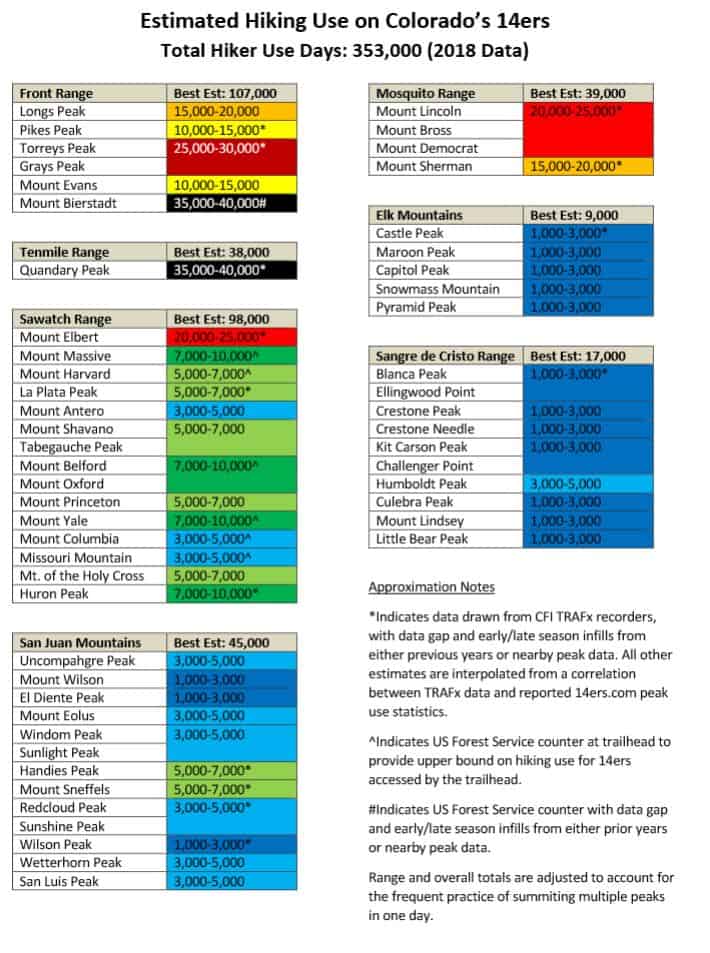Colorado Fourteeners Initiative has been studying hiking use on Colorado’s 14,000-foot peaks – the 14ers – using infrared trail counters since 2014. In 2016, CFI released its first-ever report on Fourteener hiking use and economic impact. This year, after three full seasons with 20+ thermal counters in the field, Colorado Fourteeners Initiative is releasing the third iteration of our report that estimates that Colorado’s 14ers experienced 353,000 hiker use days in 2018. This represents an increase of roughly 19,000 person days compared to CFI’s 2017 estimate of 334,000 hiker use days.
This level of recreational use suggests a statewide economic impact of more than $95 million, based on past 14er-related expenditure studies performed by Colorado State University economists John Loomis and Catherine Keske. Their 2009 study found that climbers of Quandary Peak near Breckenridge spent an average of $271.17 per day for gasoline, food, lodging, equipment, and other retail purchases.

CFI’s most recent hiking use report culminates five seasons of data collection at up to 22 sites tracking use on up to 23 14er peaks across the state. (There were five counters in 2014, 10 counters in 2015, 20 counters in 2016-2017, and 22 counters in 2018.) CFI’s hiking use projections are based on the combination of several data sources.
- CFI collected hour-by-hour data during the 2018 hiking season using TRAFx compact infrared trail counters that were placed at 22 locations adjacent to hiking trails servicing 23 Fourteener peaks.
- Hiking use projections for all other 14ers were based on crowdsourced “14er checklists” submitted to the 14ers.com website by more than 17,000 individual hikers. Estimates for peaks without trail counters were calculated using a trend line calculated by the relative frequency of reported hiking use on all peaks using data points as anchors for peaks that had counters in 2018.
- Trail counters used by the US Forest Service on Mount Bierstadt and at three trailheads serving 14ers.
A data model was developed in 2016 that helps fill in gaps in the data due to obscured counter sensors or periods in the early or late season when the counter is not in place. This model incorporates the week of the season, day of the week, holidays, and similar peaks with data to fill in missing data. If you want to dig under the hood to learn more about how these estimates were calculated, check out this explanation of the methods used.
CFI has long been interested in the amount of hiking use these popular peaks receive. Colorado’s 14ers are among the most sought-after mountain peaks in the country. They also possess some of the most fragile alpine landscapes. Hiking use is confined into a very short four-month climbing season when the mountains are largely free of snow.
Natural resource impacts in the fragile alpine tundra environment, stemming from the lack of properly designed and constructed summit trails on the 14ers, led to CFI’s founding back in 1994. Our “14er Report Card” released in 2015 showed the need for $24 million to build out and improve the summit trail network. Better understanding hiking use levels, dispersal over the climbing season, and changes over time are important factors in determining the link between hiking use and changing on-the-ground conditions of natural surface summit trails.
Special thanks goes out to Emily Barnes, CFI’s 2016 summer CLIMB intern, who performed the analysis for the 2015 and 2016 studies, and assisted in placing and downloading trail counters in 2016.
Another special thank you goes out to Nick Dahl, CFI’s 2018 summer CLIMB intern, who performed further detailed analysis and assisted in the placing and downloading of trail counters in 2018.
Additional Links:
2018 Hiking Use Report Methodology and Background
